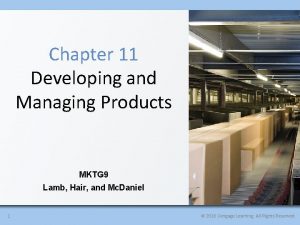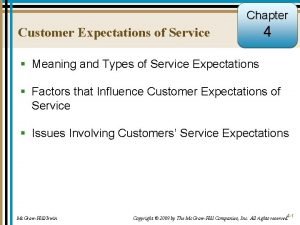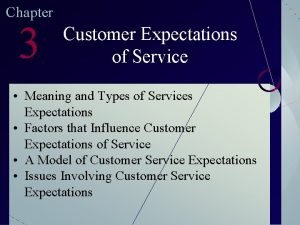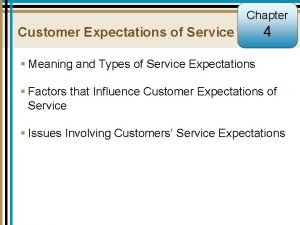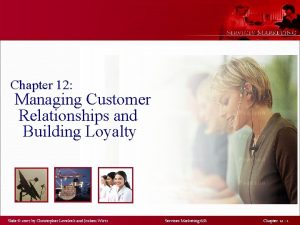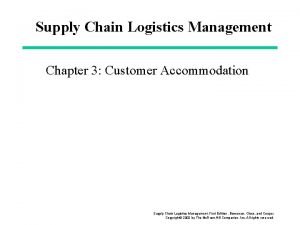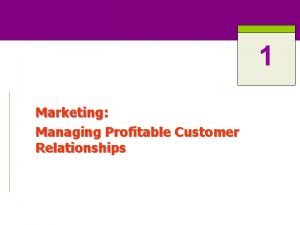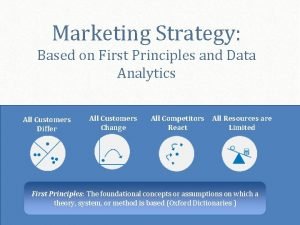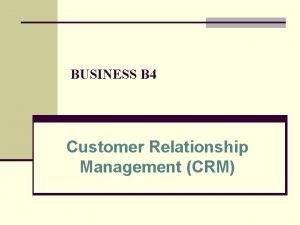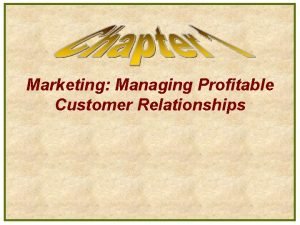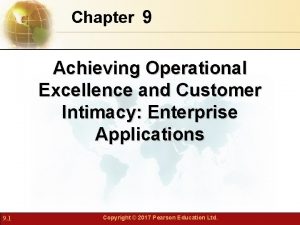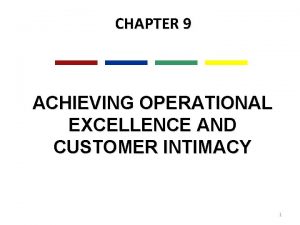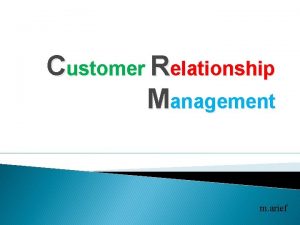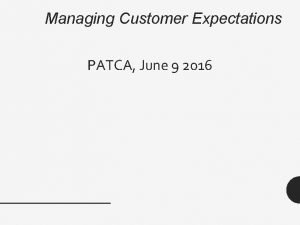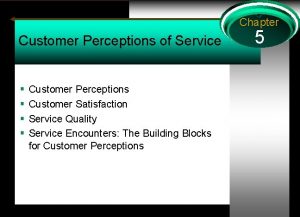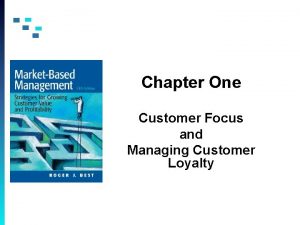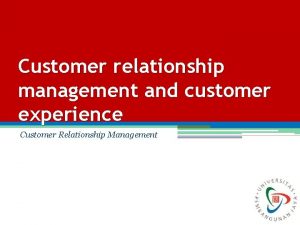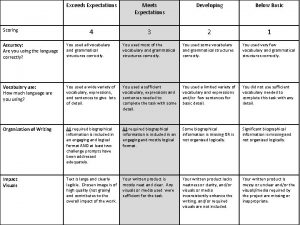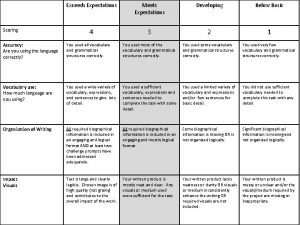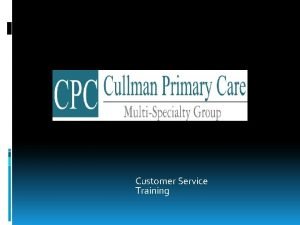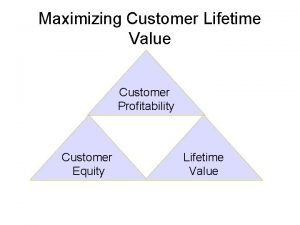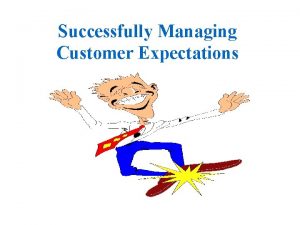Chapter 12 Developing and Managing Customer Expectations Introduction


























- Slides: 26

Chapter 12 Developing and Managing Customer Expectations

Introduction • Managing operational and tactical aspects of an organization’s IT activities is critical to long term success • Service-level agreements between customers and suppliers are an important tool, creating and managing expectations • These agreements can be used within the firm, with ASPs, with Web-hosting providers, and in many other critical relationships

Tactical and Operational Concerns • In a distributed computing environment, server failures can ripple throughout the organization – Not only are a firm’s computer operations vital, they also help to establish its image internally as well as externally – Computer operations are judged on a day to day basis • Several key operational processes must be managed well in order to succeed

Customer Expectations • Manager performance is judged by how well expectations are met – Managers must explicitly set expectations – Service-level agreements spell out commitments and expectations – Managers must choose valid measurements of service levels – Failure to attain service levels must force the organization to look for process improvements and address planning / production issues

The Disciplined Approach • Disciplines are management processes consisting of procedures, tools, and people – The goal is to meet customer expectations • Must be judged against specific, quantifiable criteria – Expectations are set in service-level agreements – Management reports are essential tools for operations managers


Service-Level Agreements • A standard tool to establish and define customer service levels – SLAs help to reduce conflicts between users and suppliers and establish user expectations – With outsourcing, IT has been forced to create SLAs in order to compete to keep operations internal – Creating these agreements requires negotiation and discussion

Service-Level Agreements • SLA negotiations are an iterative process – Requirements evolve as discussions become focused – New technology can offer benefits to the parties • The end product of SLA discussions is a written document – Costs – Services – Other contingencies (uptime, throughput)

Service-Level Agreements • Client organizations must justify IS costs – Gains from improvements must exceed costs of improvements – SLA negotiations are much simpler when preceded by careful disciplined planning • All client organizations should be included in the SLA process – SLAs need not be only confined to IT

What the SLA Includes • • Effective date of agreement Agreement duration Type of service provided Service measures – Availability – Service quantities – Performance – Reliability • Resources needed or costs charged • Reporting mechanism

What the SLA Includes • Negotiation of SLAs occur while a firm is preparing its operational plan – At this time near-term requirements for IT services are becoming clearer – Stable services like payroll have better forward visibility than quickly evolving services • Evolving services may need to renegotiate SLAs on a more frequent basis; the trigger for renegotiation must be included in the agreement

Schedule and Availability • Describes the period when the system and its application programs must be running – Includes weekends, holidays – Must allow for scheduled downtime – Should take into account seasonal fluctuations, periods of high demand • The most effective agreements are produced by negotiators who understand system capabilities, limitations, and user needs

Timing • How quickly users receive output data – For batch operations this can be measured in hours • Will the data be available at the start of the day following an overnight run? – For interactive sessions, it is the lag between request submission and result generation • Response times under 0. 3 sec appears to the user as instantaneous • The result of many factors interacting – Network speed, capacity, database access delay

E-Business Customer Expectations • E-business operations dramatically change the firm’s IS infrastructure and add new dimensions to system management – ERP systems form the heart of e-businesses • They integrate critical data from the beginning to the end of the value chain – Supporting systems are also critical • E-mail, security, funds transfer • All of the above systems must be always on and have high expectations of availability

Contracts with Outside IT Service Suppliers • When creating arrangements with outside vendors, a contract is created – Within the firm these are termed agreements denoting the fact that they do not have legal force • Contracts – Money flows outside the firm in exchange for services – Stipulates measurable rights and obligations – Give parties legal recourse

What to Include • In addition to the items in internal SLAs – Unambiguous description of the services provided and the duration of the service – Key metrics of system reliability, availability, and performance – Payment terms – Termination conditions – Remedies and indemnification

Reliability • Mean Time Between Failure (MTBF) – Amount of time system is operational and without failure – In highly redundant systems this is zero • Mean Time To Repair (MTTR) – Amount of offline time before system is operational again – This is also zero in redundant systems

Types of Service Contracts • Four distinct types – Application Service Contracts – Hosting Contracts – Network Contracts – Customer Help Desk Contracts

Workload Forecasts • Accurate forecasts are critical to meeting internal SLAs and purchasing appropriate levels of external services – Contracts must address workload fluctuations – Seasonal peaks must be anticipated – Unanticipated demands often occur when new applications or services are more successful than planned – Structural changes in the firm (mergers, etc) make invalidate previous forecasts

Workload Considerations When Outsourcing • Accurate workload forecasting is important when outsourcing – Outsourcing firms generally have contingency clauses that stipulate charges for incremental demand – In cases where demand is significantly underestimated, these charges can exceed the initial contract price – In cases of underestimation, monthly charges inflate final application service cost

Measurements of Satisfaction • Suppliers and users must agree on explicit, transparent, and credible metrics – Accurate data creates trust with clients and builds a relationship – Suppliers should measure performance from the client’s perspective – Metrics should be gathered from across a client’s network, so that site specific problems can be identified and overall performance accurately reported

User Satisfaction Surveys • Aside from meeting SLAs, providers must gather data on user perceptions of service – Well crafted surveys help to detect problems sooner – Unsatisfactory results must be addressed and the roots of the difficulty found • Focus groups, targeted surveys, etc – This becomes another method to strengthen communication between users and providers

E-Business Satisfaction Measurements • Customer satisfaction is critical for success in e-business – Objective measures must be found to track customer satisfaction – Anonymous data must be collected in a timely manner that allows participants to opt-out – In B 2 B ventures, issues such as trust and competition can cloud users perceptions – B 2 C e-commerce is even more difficult with branding, advertising, and marketing affecting results

Additional Considerations • Resistance to SLAs occurs at times because managers feel that they represent unnecessary bureaucracy and central control • Some managers resist because SLAs would reign in their ability to demand bully • Others would like to operate their departments without the scrutiny that SLAs bring to ongoing operations and performance

Congruence of Expectations and Performance • Sometimes SLA performance does not meet expectations – Inability to meet SLAs allow an organization the opportunity to re-engineer, conduct strategic planning, or consider outsourcing of the function – The utility of this approach is that previously hidden problems are formalized, measured, and addressed

Summary • SLAs form the basis of services to ebusinesses • They create a foundation upon which the disciplines can be made effective • SLAs creates respect and communication between providers and clients • It helps IT to focus on client needs and clients to understand the services IT renders
 Managing marketing information to gain customer insights
Managing marketing information to gain customer insights Developing and managing products
Developing and managing products Brand &+product type l1
Brand &+product type l1 Developing and managing products
Developing and managing products Developing and managing products
Developing and managing products Developing and managing products
Developing and managing products Quality is meeting or exceeding customer expectations
Quality is meeting or exceeding customer expectations Possible levels of customer expectations
Possible levels of customer expectations Dual customer expectation levels
Dual customer expectation levels Service expectations meaning
Service expectations meaning Implicit service promises examples
Implicit service promises examples Explicit customer expectations
Explicit customer expectations Possible levels of customer expectations
Possible levels of customer expectations Managing customer relationships and building loyalty
Managing customer relationships and building loyalty Customer accommodation in supply chain management
Customer accommodation in supply chain management Marketing is managing profitable customer relationships
Marketing is managing profitable customer relationships Aer strategy marketing
Aer strategy marketing Involves managing all aspects of a customer relationship
Involves managing all aspects of a customer relationship Managing profitable customer relationships
Managing profitable customer relationships Customer relationship management and customer intimacy
Customer relationship management and customer intimacy Customer relationship management and customer intimacy
Customer relationship management and customer intimacy Customer relationship management and customer intimacy
Customer relationship management and customer intimacy Charles dickens presentation
Charles dickens presentation Perbedaan customer relation dan customer service
Perbedaan customer relation dan customer service Beyond customer satisfaction
Beyond customer satisfaction Chapter 8 training and developing employees
Chapter 8 training and developing employees The central instrument for directing and coordinating
The central instrument for directing and coordinating

